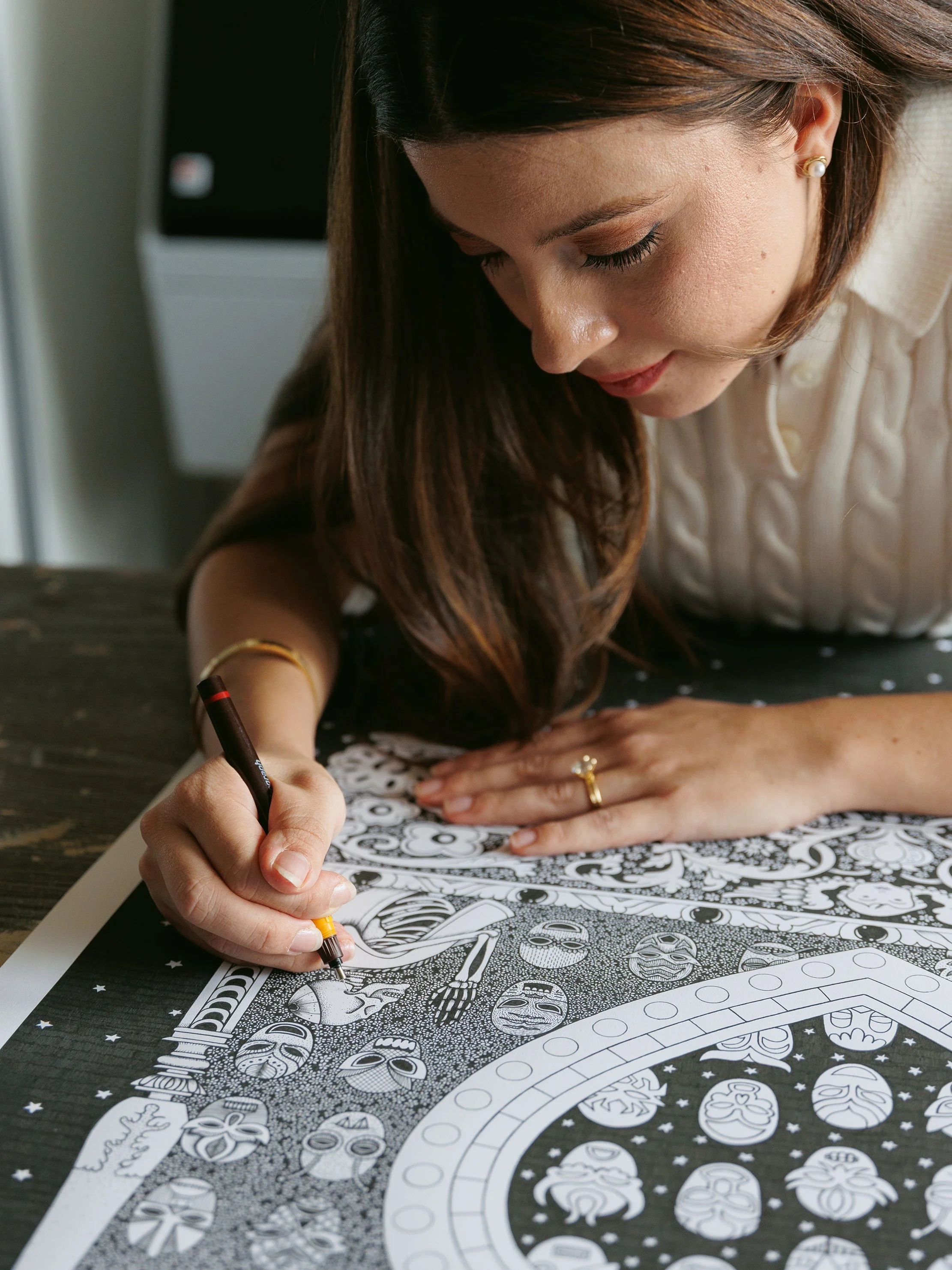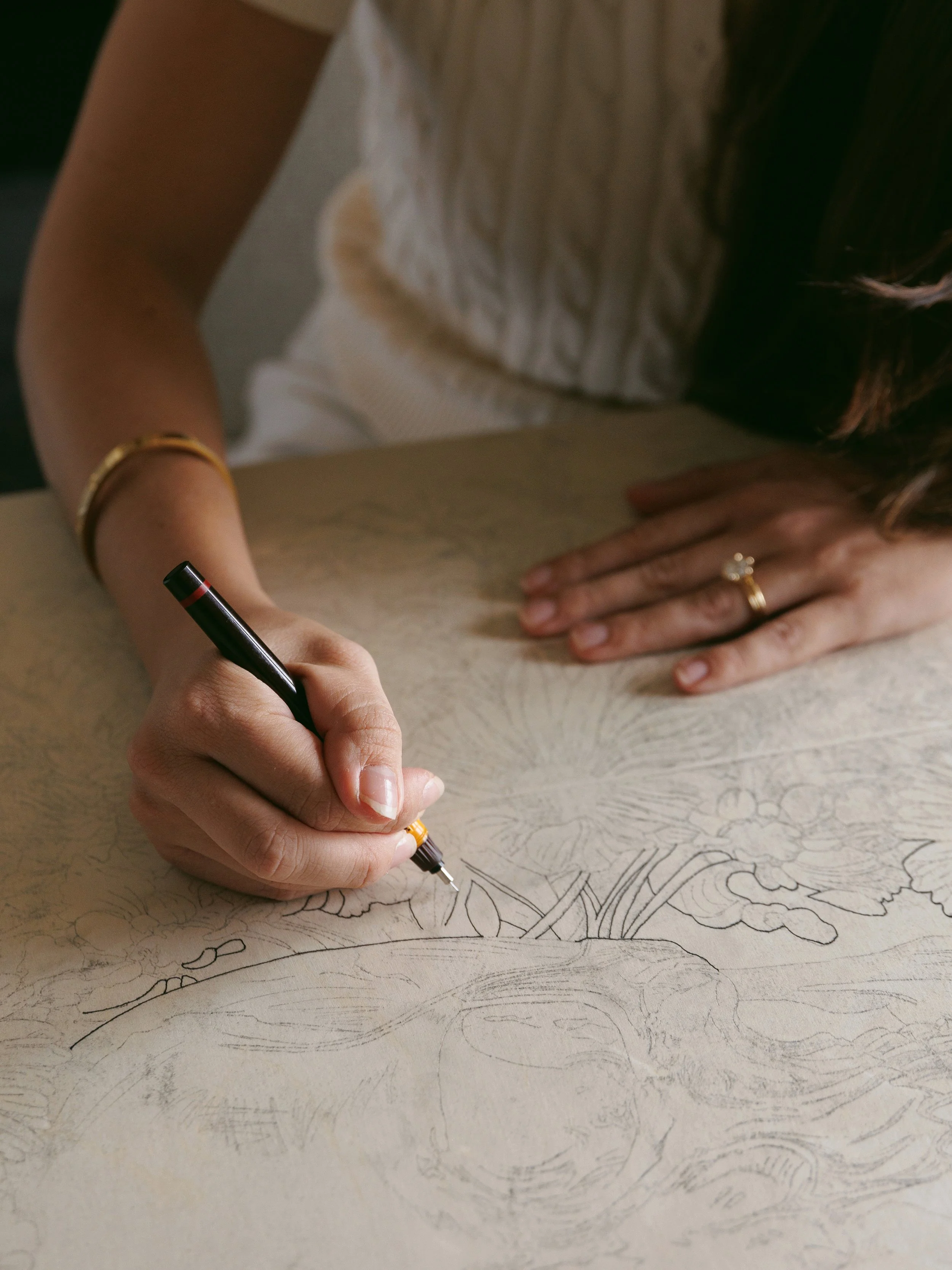Interview
Laura Clay Robson
Laura Clay is a Mexican-American artist based in Austin, specializing in painting and drawing. Her abstract paintings feature gradients, textures, and a balance between organic and geometric forms, reflecting her exploration of bicultural identity and the tension between chaos and order. She creates her own handmade paints and uses high-quality materials, including architectural pens and archival paper, to craft detailed fine-line drawings. She holds an MFA from the National Art School in Sydney, Australia, a BFA from Texas Christian University, and has studied fine art at Instituto Allende in San Miguel de Allende, Mexico. She also completed a year at the Corcoran College of Art + Design in Washington, D.C., now part of George Washington University. Her work has been acquired by Mexic-Arte Museum for its permanent collection and has been featured in publications such as Eastside Magazine. With over 60 exhibitions and art fairs worldwide, she is currently represented by Washington Gallery Waco and The Cathedral ATX. Through abstraction, Laura’s work navigates themes of displacement, balance, and identity, offering an immersive exploration of form and cultural narrative.
What is your background and how did you start your journey in the art world?
“I am a Mexican-American artist based in Austin, specializing in painting and drawing. My journey in the art world began as a child growing up between Mexico and the United States, experiencing two cultures that shaped my perspective on identity and belonging. Art became a way for me to process and express these dualities, melding the rich traditions and history of Mexico with the structural techniques and ambition nurtured in the U.S. I pursued my formal education in fine art at Texas Christian University and later earned my MFA in Painting from the National Art School in Sydney, Australia. My studies in San Miguel de Allende, Mexico, further deepened my connection to traditional Mexican artistic practices. Over time, my work has evolved into an exploration of balance - between chaos and order, organic and geometric, past and present.”
What inspires you?
“I draw inspiration from my bicultural heritage, personal experiences of movement and transition, and the interplay between structure and spontaneity in nature and human existence. I am deeply influenced by the contrast between organic, free-flowing elements and rigid, geometric precision, a tension that reflects my own navigation between two cultural identities. I also find inspiration in architecture, textiles, and historical Mexican art forms, particularly in the intricate details of folk art and Día de los Muertos symbolism. The materials I use are equally important to my inspiration; I create my own handmade paints and use architectural pens and archival paper to enhance the tactile and enduring qualities of my work. The materials I use play a crucial role in my creative process and artistic philosophy. I am deeply invested in the quality and origin of my materials, which directly influences the final outcome of my work. One of the most significant aspects of my practice is my use of handmade paints, crafted from natural pigments. One of my favorite and most meaningful pigments comes from cochineal, a small insect found on nopal cacti in Mexico. When harvested and processed, cochineal produces an incredibly rich red pigment that has been used for centuries in Mexican and Indigenous art, textiles, and murals. By incorporating this traditional method into my own practice, I feel a deep connection to history and the artisans who came before me.”
What themes do you pursue? Is there an underlying message in your work?
“My work is an exploration of bicultural identity, movement, and balance. I often investigate the tension between chaos and order, reflecting the fluidity and structure found in both nature and human experience. Through gradients, texture, and abstraction, I explore how identities are shaped, layered, and sometimes contradictory. My pieces serve as visual metaphors for the process of finding harmony within duality - whether that be cultural, emotional, or physical. A recurring theme in my work is the idea that identity is not fixed but rather a constantly shifting horizon.”
How would you describe your work?
“My work is abstract yet deeply personal, blending organic textures with geometric structure to create compositions that explore identity, movement, and transformation. My paintings feature gradients and layered textures that suggest fluidity and impermanence, while my fine-line drawings are meticulously detailed, often incorporating stippling techniques that echo traditional Mexican artistry. I work primarily with handmade paints, architectural pens, and archival materials to ensure depth, richness, and longevity in my pieces. Whether through bold color transitions or delicate black-and-white illustrations, my art exists at the intersection of tradition and contemporary abstraction.”
Which artists influence you most?
“My influences span multiple artistic movements and personal experiences, shaping how I approach color, form, and materiality in my work. One of my earliest and most significant influences is my grandmother, Mary Clay Hernández. I painted beside her every day for four years while studying at TCU, learning not just about technique but about the deeper impact of materials and storytelling in painting. One of her most striking works depicted crosses in the desert, marking the graves of immigrants who had died attempting to cross the U.S.-Mexico border. She visited the site, collected sand, and incorporated it into her painting, embedding a physical and symbolic connection to the land and its history. This approach deeply resonated with me, reinforcing my own exploration of material as meaning - whether it’s collecting natural pigments or using handmade paints to enhance the conceptual depth of my work. In terms of color theory, Josef Albers’ Interaction of Color has been foundational. His studies on how color relationships shift depending on their context have influenced my use of gradients and contrast to evoke emotional and spatial depth. Similarly, Helen Frankenthaler’s soaked-stain technique and approach to color as a compositional force resonate with my own fluid layering process. From the Color Field movement, Morris Louis, Kenneth Noland, and Paul Reed have played an essential role in shaping my approach to balance, movement, and structure. While at the Corcoran College of Art + Design in Washington, D.C., I lived next to Paul Reed, one of the founding members of the Washington Color Painters. He became a mentor and dear friend, sharing insights about color interaction, materiality, and the intentionality behind formal choices. His influence is evident in my interplay between controlled geometric compositions and expressive, organic forms. Collectively, these influences have shaped my artistic language, allowing me to explore the tensions between order and fluidity, cultural duality, and the impact of materiality in abstraction.”
“My work is abstract yet deeply personal, blending organic textures with geometric structure to create compositions that explore identity, movement, and transformation.”
What is your creative process like?
“My process begins with an exploration of material and movement. I often start by mixing my own paints, experimenting with pigments and textures to find the right balance of opacity and fluidity. For my paintings, I work in layers, allowing colors to bleed and blend naturally before refining edges with structured, geometric elements. My drawings are more meticulous, often beginning with freehand sketches that evolve into intricate fine-line compositions using stippling techniques. I am drawn to the contrast between spontaneity and precision, and I embrace the unexpected ways materials interact on the canvas or paper. My process is both intuitive and disciplined, reflecting the dual themes present in my work.”
What is an artist’s role in society and how do you see that evolving?
“Artists serve as translators of culture, history, and personal experience. We document and interpret the world around us, providing alternative perspectives and opening conversations about identity, place, and meaning. In a world increasingly shaped by digital immediacy, I believe the role of the artist is to create work that invites slow engagement - art that encourages contemplation and deeper connection. As technology advances, I see the importance of tactile, handcrafted art increasing, as people seek experiences that feel grounded and human. I hope to continue contributing to this space by creating work that bridges past and present, personal and universal.”
Have you had any noteworthy exhibitions you'd like to share?
“I have participated in over 60 exhibitions and art fairs worldwide, but a few stand out as pivotal moments in my career. My work was acquired by the Mexic-Arte Museum for its permanent collection, which was a profound honor as it affirmed my connection to the larger narrative of Mexican-American artistry. Being featured on the cover of Eastside Magazine, along with an artist interview, helped introduce my work to a wider audience. My participation in both national and international exhibitions has allowed me to engage with different artistic communities and explore how my themes resonate across cultures. Additionally, I am currently represented by Washington Gallery Waco and The Cathedral ATX, where my work continues to be shown and collected.”
Website: www.lauraclayart.com
Instagram: @lauraclayart











